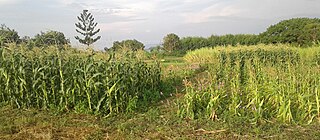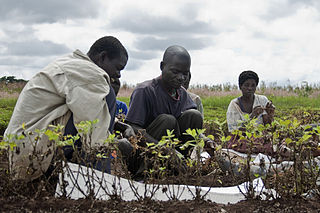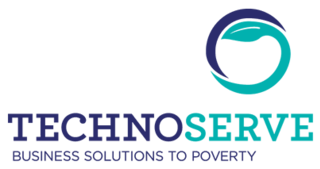
The International Maize and Wheat Improvement Center is a non-profit research-for-development organization that develops improved varieties of wheat and maize with the aim of contributing to food security, and innovates agricultural practices to help boost production, prevent crop disease and improve smallholder farmers' livelihoods. CIMMYT is one of the 15 CGIAR centers. CIMMYT is known for hosting the world's largest maize and wheat genebank at its headquarters in Mexico.

A smallholding or smallholder is a small farm operating under a small-scale agriculture model. Definitions vary widely for what constitutes a smallholder or small-scale farm, including factors such as size, food production technique or technology, involvement of family in labor and economic impact. Smallholdings are usually farms supporting a single family with a mixture of cash crops and subsistence farming. As a country becomes more affluent, smallholdings may not be self-sufficient, but may be valued for the rural lifestyle. As the sustainable food and local food movements grow in affluent countries, some of these smallholdings are gaining increased economic viability. There are an estimated 500 million smallholder farms in developing countries of the world alone, supporting almost two billion people.

Malawi is one of the world's undeveloped countries and is ranked 170 out of 187 countries according to the 2010 Human Development Index. It has about 16 million people, 53% of whom live under the national poverty line, and 90% of whom live on less than $2 per day.

Push–pull technology is an intercropping strategy for controlling agricultural pests by using repellent "push" plants and trap "pull" plants. For example, cereal crops like maize or sorghum are often infested by stem borers. Grasses planted around the perimeter of the crop attract and trap the pests, whereas other plants, like Desmodium, planted between the rows of maize, repel the pests and control the parasitic plant Striga. Push–pull technology was developed at the International Centre of Insect Physiology and Ecology (ICIPE) in Kenya in collaboration with Rothamsted Research, UK. and national partners. This technology has been taught to smallholder farmers through collaborations with universities, NGOs and national research organizations.
The Collaborative Crop Research Program (CCRP) funds participatory, collaborative research on agroecological intensification (AEI). Funded projects typically link international, national, and local organizations with communities of smallholder farmers, researchers, development professionals, and other parties. Projects work together as part of a Community of Practice to generate technical and social innovations to improve nutrition, livelihoods, and productivity for farming communities in Africa and South America. Large-scale impact is realized when new ideas, technologies, or processes are adapted, when insights from research catalyze change in policy and practice, and when innovation inspires further success. The program is under the direction of Rebecca J. Nelson of Cornell University and Jane Maland Cady of the McKnight Foundation.

The main economic products of Malawi are tobacco, tea, cotton, groundnuts, sugar and coffee. These have been among the main cash crops for the last century, but tobacco has become increasingly predominant in the last quarter-century, with a production in 2011 of 175,000 tonnes. Over the last century, tea and groundnuts have increased in relative importance while cotton has decreased. The main food crops are maize, cassava, sweet potatoes, sorghum, bananas, rice, and Irish potatoes and cattle, sheep and goats are raised. The main industries deal with agricultural processing of tobacco, tea and sugar and timber products. The industrial production growth rate is estimated at 10% (2009).
Uganda's favorable soil conditions and climate have contributed to the country's agricultural success. Most areas of Uganda have usually received plenty of rain. In some years, small areas of the southeast and southwest have averaged more than 150 millimeters per month. In the north, there is often a short dry season in December and January. Temperatures vary only a few degrees above or below 20 °C but are moderated by differences in altitude.

Agriculture in Kenya dominates Kenya's economy. 15–17 percent of Kenya's total land area has sufficient fertility and rainfall to be farmed, and 7–8 percent can be classified as first-class land. In 2006, almost 75 percent of working Kenyans made their living by farming, compared with 80 percent in 1980. About one-half of Kenya's total agricultural output is non-marketed subsistence production.

Self Help Africa is an international charity that promotes and implements long-term rural development projects in Africa. Self Help Africa merged with Gorta in July 2014, and in 2021 merged with UK-based INGO, United Purpose. The organisation also owns a number of social enterprise subsidiaries - Cumo Microfinance, TruTrade and Partner Africa.
Innovations for Poverty Action (IPA) is an American non-profit research and policy organization founded in 2002 by economist Dean Karlan. Since its foundation, IPA has worked with over 400 leading academics to conduct over 900 evaluations in 52 countries. The organization also manages the Poverty Probability Index.

Farm Radio International, or Radios Rurales Internationales, is a Canadian non-profit organization that was founded in 1979 by CBC Radio broadcaster George Atkins. The organization is headquartered in Ottawa, Ontario and works with radio broadcasters to improve food security and agricultural methods for small-scale farmers and rural communities in African countries.

TechnoServe is an international nonprofit that promotes business solutions to poverty in the developing world by linking people to information, capital and markets. It is a registered 501(c)(3) based in Washington, D.C., with over 1,540 employees across 29 countries worldwide.

Striga hermonthica, commonly known as purple witchweed or giant witchweed, is a hemiparasitic plant that belongs to the family Orobanchaceae. It is devastating to major crops such as sorghum and rice. In sub-Saharan Africa, apart from sorghum and rice, it also infests maize, pearl millet, and sugar cane.
Alliance for a Green Revolution in Africa (AGRA) is an organisation that seeks to transform African agriculture from a subsistence model to strong businesses that improve the livelihoods of the continent’s farming households.
The Agricultural Development and Marketing Corporation, usually known as ADMARC, was formed in Malawi in 1971 as a government-owned corporation or parastatal to promote the Malawian economy by increasing the volume and quality of its agricultural exports, to develop new foreign markets for the consumption of Malawian agricultural produce and to support Malawi's farmers. it was the successor of a number of separate marketing boards of the colonial-era and early post-colonial times, whose functions were as much about controlling African smallholders or generating government revenues as in promoting agricultural development. At its foundation, ADMARC was given the power to finance the economic development of any public or private organisation, agricultural or not.
Wefarm was a peer-to-peer knowledge sharingsocial network for smallholder farmers in the developing world. The network enabled users to ask and answer questions and share tips about agriculture and business, via SMS or online, enabling farmers in rural areas without internet access to share information. Wefarm claimed to be the world's largest farmer-to-farmer network. It raised more than $10m in venture capital before going out of business in 2022.
Mary Mgonja, is a Tanzanian agricultural scientist and plant breeder, who works as the director for technology and communication at Namburi Agricultural Company Limited, a private Tanzanian agricultural enterprise.
The Nyasaland famine of 1949 was a famine that occurred in the Shire Highlands in the Southern Province of Nyasaland and also in a part of the Central Province in 1949: its effects extended into the early part of 1950. The immediate cause was severe droughts in December 1948 to January 1949 and in March 1949 that destroyed much of the maize crop on which the people of the affected areas relied during its main growing season. This followed two years of erratic rainfall and poor harvests which had depleted the reserves in farmers’ granaries. The effect of crop failure was intensified by the failure of the colonial government to maintain a suitably large emergency grain reserve, delays in importing sufficient relief supplies and its requirement that most of the relief provided was paid for by its recipients. The official death toll from starvation was some 200 people, which may be an underestimate, and it excludes those dying of diseases exacerbated by malnutrition.
A number of movements seek to expand the practice of agroecology in West Africa. Agroecology is a scientific discipline, movement and practice that integrates ecology in agriculture with strong emphasis on diversification, food sovereignty, energy efficiency and sustainability. Agroecological practices apply the systems and knowledge that traditional farmers in the region have developed and inherited. The agroecological social movement empowers smallholder farmers that hold the knowledge of indigenous farming systems, however are recently engulfed by larger farms or are migrating to urban areas, looking for better paying jobs.

Babban Gona, which means "Great Farm" in the Hausa language, is a social enterprise organization that provides support for smallholder farmers in Nigeria to become more profitable.











